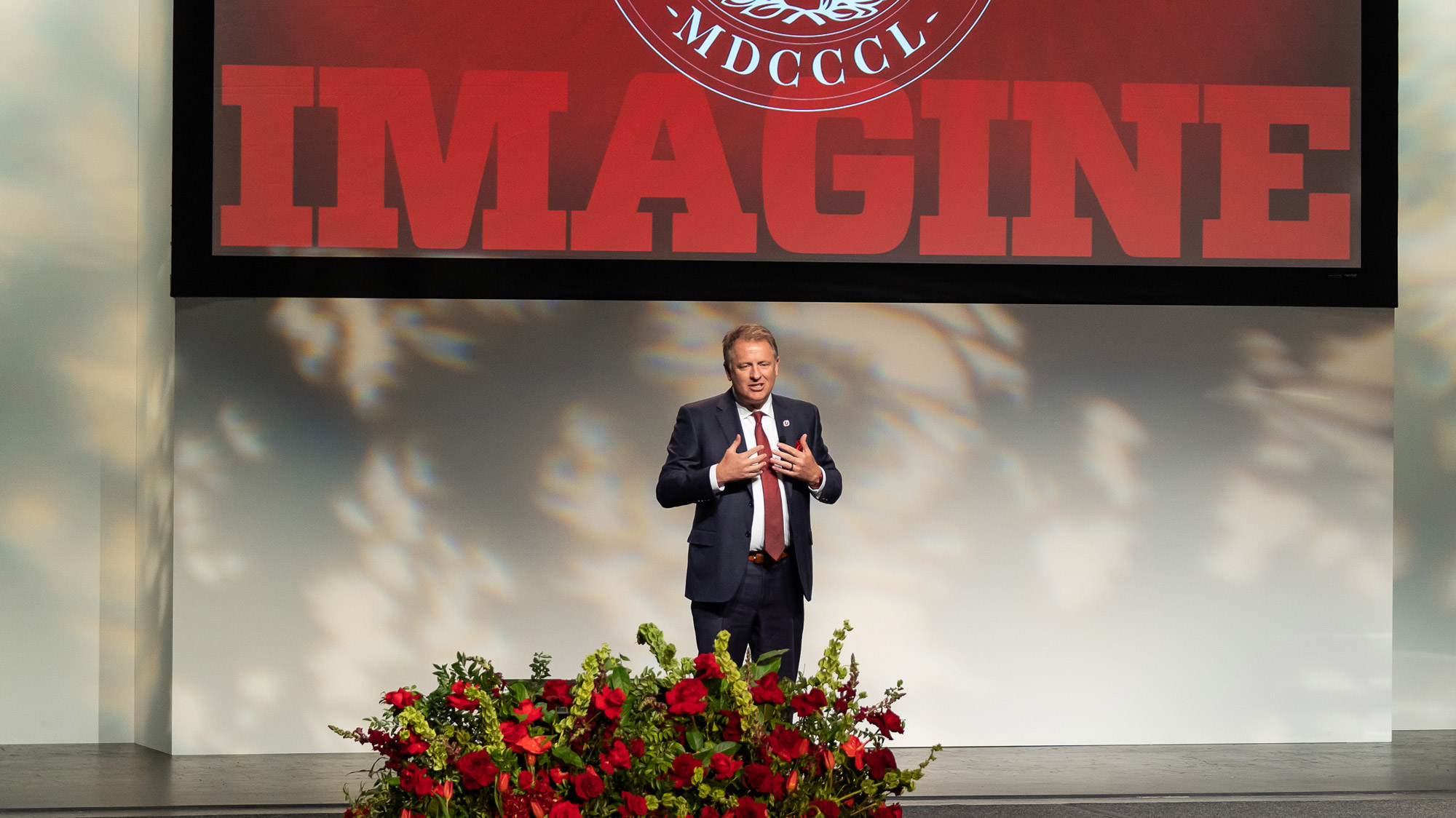
“I” was the letter of the day, as Taylor Randall was inaugurated as the 17th president of the University of Utah. His speech was built around three I’s: imagine, innovate, and impact. The alliterative theme was bolstered with the addition of “inspire,” as President Randall spent much of his speech outlining a future-oriented view for the university.
Randall expressed gratitude in the opening of his speech, noting the magnitude of the opportunity to serve as president at the U of U, and outlining the variety of people who paved the way for him to develop and gain the experience necessary for the opportunity.
As the gratitudes were expressed, Randall turned his attention to the future. He led off by outlining a vision for a university with imagination. “The word imagine is one of the most powerful and evocative words in the English language. Why? Because it evokes something personal. It evokes something aspirational. If you listen to its call, it becomes a call to build a better version of ourselves, a call to make sure everyone belongs, a call to be part of something bigger than what we are now. It’s a call to make the world a much, much better place.”
Randall often invoked the idea of re-imagining. “When I reimagine something, I form a mental image that becomes so powerful that it looks like a future, that it becomes so inspiring, that it becomes so impactful that it unifies… I imagine a future that inspires, a future that innovates, and a future with enormous impact.”
Randall spoke glowingly of a rising generation of students and trainees who are conscientious and who desire to take on contemporary problems. He suggested, “we need to think of our campus as more than a classroom and more like an experience, a playground where absolutely anything can be possible. And this begins, literally, by building a campus that integrates learning, living, and the world around us.”
With this bold tone, focused on providing current and future generations of students with the resources needed to succeed in an integrated campus environment, Randall proceeded to announce the building of the Sorenson-Gay Impact Epicenter, which is intended to further set the tone of integrating a variety of research with student life.
As the speech continued, Randall invoked his second “I”: innovate. In doing so, Randall outlined three major roles the societal institution of universities have filled over time: teaching the basics, research, and—contemporarily—entrepreneurship. As he noted that we may be entering this era of universities catalyzing entrepreneurship, he suggested that role can be filled as universities take knowledge to the community where that knowledge can have an increasingly swift impact.
To reinforce the idea of carrying knowledge to communities through university entrepreneurship, Randall laid down several notable milestones, marking impactful research at the U of U. He specifically noted the first NIH grant received at the U by Max Wintrobe, as he studied muscular dystrophy.
He continued, “as our health enterprise grew, we began to put artificial hearts in people. In 1982, a 61-year-old patient, Barney Clark received the world’s first artificial heart… Researchers now have discovered many of our cancer-causing genes, including breast, colon, and skin cancer. These are all groundbreaking achievements, but we are now poised to leverage that basic research talent.”
Randall went on the suggest that his research agenda has two re-imaginings.
First, “we just simply need to do more research. We will, over the next seven years, secure and sustain $1 billion in annual research funding from the major research institutes of the United States. This research needs to be closely tied to the major challenges of our day.”
To reinforce the importance of doing more research, Randall noted important research that is happening at the U of U, speaking to the need to empower more of it. “I want to see the research of Eric Garland on the opioid crisis and how to solve it get implemented at scale in our communities. I want to see Michelle Litchman’s research on diabetes change policy in the United States. I want to see Florian Solzbacher’s research on the brain-computer interface implemented through his company Blackrock Neurotech.”
“The second re-imagining,” Randall continued, “is that we have to [pick up the speed] with which our research hits the market, make it faster. We will, over the next five years, invest $100 million in concepts that I will call greenhouses. These will bring applied researchers together with fundamental research and catalytic capital to try and move our research quicker into the market.”
Randall closed the speech with his third “I”: impact. Impact was often implicit throughout the speech, but he noted that the university can and will go out to the state of Utah, rather than having the traditional inverse relationship. Indeed, as President Randall envisions a University of Utah that imagines and innovates, the hope is to inspire and have an impact.